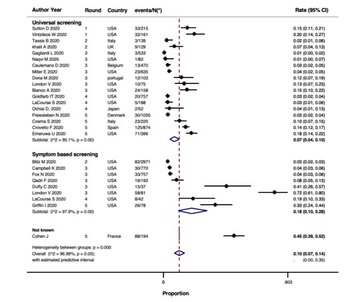Allotey, John*, Stallings, Elena*, Bonet, Mercedes, …, Zamora, Javier, Thangaratinam, Shakila. Clinical manifestations, risk factors, and maternal and perinatal outcomes of coronavirus disease 2019 in pregnancy: living systematic review and meta-analysis.
BMJ 2020
This work is part of an international collaboration between the World Health Organization, University of Birmingham and ourselves among many others. It is the first article from a bigger project called PregCOV-19LSR. Stay tuned!" - Elena C. Stallings & Dr. Javier Zamora-
Summary:
Objective: To determine the clinical manifestations, risk factors, and maternal and perinatal outcomes in pregnant and recently pregnant women with suspected or confirmed coronavirus disease 2019 (covid-19).
Design: Living systematic review and meta-analysis.
Data sources: Medline, Embase, Cochrane database, WHO COVID-19 database, China National Knowledge Infrastructure (CNKI), and Wanfang databases from 1 December 2019 to 26 June 2020, along with preprint servers, social media, and reference lists.
Study selection: Cohort studies reporting the rates, clinical manifestations (symptoms, laboratory and radiological findings), risk factors, and maternal and perinatal outcomes in pregnant and recently pregnant women with suspected or confirmed covid-19.
Data extraction: At least two researchers independently extracted the data and assessed study quality. Random effects meta-analysis was performed, with estimates pooled as odds ratios and proportions with 95% confidence intervals. All analyses will be updated regularly.
Results: 77 studies were included. Overall, 10% (95% confidence interval 7% to14%; 28 studies, 11 432 women) of pregnant and recently pregnant women attending or admitted to hospital for any reason were diagnosed as having suspected or confirmed covid-19. The most common clinical manifestations of covid-19 in pregnancy were fever (40%) and cough (39%). Compared with non-pregnant women of reproductive age, pregnant and recently pregnant women with covid-19 were less likely to report symptoms of fever (odds ratio 0.43, 95% confidence interval 0.22 to 0.85; I2=74%; 5 studies; 80 521 women) and myalgia (0.48, 0.45 to 0.51; I2=0%; 3 studies; 80 409 women) and were more likely to need admission to an intensive care unit (1.62, 1.33 to 1.96; I2=0%) and invasive ventilation (1.88, 1.36 to 2.60; I2=0%; 4 studies, 91 606 women). 73 pregnant women (0.1%, 26 studies, 11 580 women) with confirmed covid-19 died from any cause. Increased maternal age (1.78, 1.25 to 2.55; I2=9%; 4 studies; 1058 women), high body mass index (2.38, 1.67 to 3.39; I2=0%; 3 studies; 877 women), chronic hypertension (2.0, 1.14 to 3.48; I2=0%; 2 studies; 858 women), and pre-existing diabetes (2.51, 1.31 to 4.80; I2=12%; 2 studies; 858 women) were associated with severe covid-19 in pregnancy. Pre-existing maternal comorbidity was a risk factor for admission to an intensive care unit (4.21, 1.06 to 16.72; I2=0%; 2 studies; 320 women) and invasive ventilation (4.48, 1.40 to 14.37; I2=0%; 2 studies; 313 women). Spontaneous preterm birth rate was 6% (95% confidence interval 3% to 9%; I2=55%; 10 studies; 870 women) in women with covid-19. The odds of any preterm birth (3.01, 95% confidence interval 1.16 to 7.85; I2=1%; 2 studies; 339 women) was high in pregnant women with covid-19 compared with those without the disease. A quarter of all neonates born to mothers with covid-19 were admitted to the neonatal unit (25%) and were at increased risk of admission (odds ratio 3.13, 95% confidence interval 2.05 to 4.78, I2=not estimable; 1 study, 1121 neonates) than those born to mothers without covid-19.
Conclusion: Pregnant and recently pregnant women are less likely to manifest covid-19 related symptoms of fever and myalgia than non-pregnant women of reproductive age and are potentially more likely to need intensive care treatment for covid-19. Pre-existing comorbidities, high maternal age, and high body mass index seem to be risk factors for severe covid-19. Preterm birth rates are high in pregnant women with covid-19 than in pregnant women without the disease.
Why do you highligth this publication?
This paper answers clinically relevant questions for pregnant women, who can be considered a high-risk population. It is the product of an intensive international collaboration over the period of 5 months while we were living through the pandemic. We used a novel review methodology where we updated the searches every week, making it a living systematic review. This method is especially important during the time of the pandemic since new studies are constantly emerging as we are learning about the virus.
Publication commented by:
Elena C. Stallings & Dr. Javier Zamora
Clinical Biostatistics Unit
Hospital Universitario Ramón y Cajal



